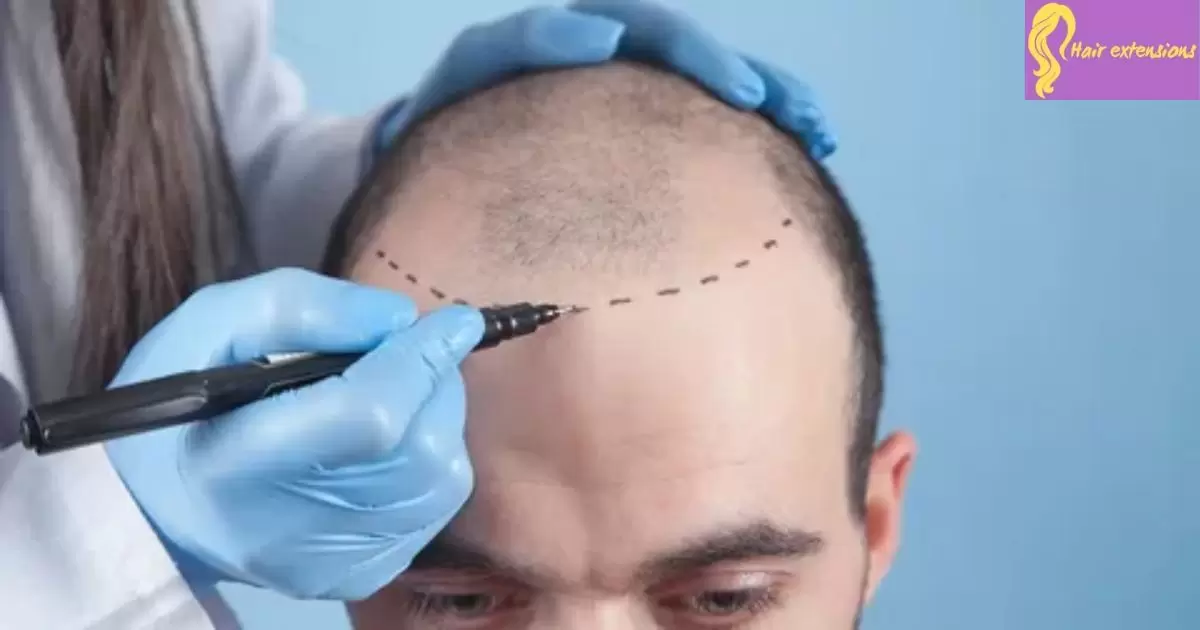Thinning hair may be distressing, however, hair extensions may offer an answer. By including volume and period, splendid extensions can create the phantasm of fuller, thicker hair. However, extensions no longer deal with the underlying reasons for thinning hair. Proper application and removal are key to avoiding further damage. When used properly, hair extensions can temporarily restore confidence while more permanent solutions are explored.
Do you have thinning hair? Are you worried about going bald? Many boys your age do. You want your hair to look good. Will hair extensions help thinning hair? Some say yes. Hair extensions are greater hair you add to your hair. They make your hair appearance thicker and fuller. But hair extensions do not repair the hassle. Talk to your doctor in case your hair is thinning. They can help you find solutions.
Hair extensions are synthetic or real hair connected to feature quantity. For people with thinning hair, extensions can temporarily create the advent of thicker locks. However, extensions no longer deal with underlying reasons for hair loss and thinning. Proper application and removal are key to avoid further damage. Extensions provide short-term cosmetic coverage but see a dermatologist for medical treatments to address thinning hair.
Evaluating the pros and cons of extensions.
Extensions can provide length and volume, helping you change up your look. However, they also come with risks like damage and high maintenance. Considering the pros and cons helps determine if extensions are right for you.
Extensions allow you to get long, luscious locks instantly. They can also add fullness and thickness. With customizable options, you can achieve virtually any style. Extensions conveniently avoid the growing out process. However, they’re not as low maintenance as your natural hair. Proper care is required to avoid matting and shedding. The costs also accumulate over time.
Can extensions damage natural hair long?

Extensions can cause long-term damage when not properly installed and removed. The weight of extensions puts constant tension on your natural hair which can weaken the follicles. This causes breakage over time, especially when extensions are left in too long.
Using adhesives also damages the hair by pulling on strands during removal. Clip-in extensions avoid this glue damage. Proper removal by a stylist reduces the risk, as does regularly moving extension placement. Overall, you must properly care for your natural hair beneath extensions to avoid lasting damage.
Extension options like tape-ins vs clip-ins
When choosing extensions, tape-ins and clip-ins are two popular options. Tape-in extensions use adhesive strips to bond to sections of your natural hair. Clip-ins attach via built-in snap clips.
Tape-ins create a seamless look and can last 4-8 weeks with proper care. But they do require a stylist for removal to avoid damage. Clip-ins allow you to add length and volume on your own in minutes. They don’t damage the hair, but may not look as natural. Consider your budget, lifestyle and hair health when weighing these extensions against each other.
Proper extension weight for thinning hair
Choosing lightweight extensions is crucial if you have fine or thinning hair. Heavy extensions can pull on delicate strands, causing excessive shedding and damage. A good rule of thumb is to ensure the extensions weigh less than the hair they’re attached to.
Human hair extensions around 120 grams are a safe option for thinning hair. Going below 100 grams is ideal. Opt for fewer wider wefts over more that are too close together. Also, avoid overloading your hairline or crown with excess extensions. Consulting a stylist helps determine the proper weight for your unique hair.
Targeting hair loss triggers like stress.

Stress is a common however regularly neglected trigger of hair loss. Stress produces hormones like cortisol that could disrupt the hair increase cycle. Prolonged or severe stress causes more hairs than normal to enter the shedding telogen phase.
Practicing daily stress management helps lower cortisol levels. This includes relaxation techniques like meditation and yoga. Adjusting your diet to reduce inflammation can support hair health. Supplements like biotin, vitamin D, and zinc also help counteract nutritional deficiencies that worsen hair loss. While you can’t eliminate all stress, mitigating its impact protects your hair.
Scalp micropigmentation is an alternative.
Scalp micro pigmentation is a beauty hair loss solution that tattoos tiny dots alongside the scalp. This creates the phantasm of shaved hair follicles to imitate the appearance of a buzzcut as hair thins. The results appear natural and last for years with touch-ups.
Compared to transplants, micropigmentation is more affordable and lower maintenance. It can also complement transplants and conceal scars. However, it doesn’t stimulate hair regrowth. Combining micro pigmentation with medications like minoxidil and finasteride improves visible density. It’s an excellent option for those not yet ready for transplants. Just ensure proper practitioner training, since the scalp is susceptible.
Hair thickening products to use with extensions

Extensions look their best when paired with products that create the illusion of thicker hair beneath. Volumizing powders absorb oil and add texture at the roots for lift. Similarly, dry shampoos cleanse hair while leaving behind volumizing starches.
Thickening sprays coat strands to make hair look denser overall. Caffeine shampoos and serums stimulate the scalp to extend the hair growth phase. Using these before and during the extension process optimizes fullness. However, overuse can lead to buildup. Focus on scalp health with gentle cleansing and massage to support thickness.
Good salon hygiene to prevent infection
| Hygiene Practice | Description |
| Clean tools | Wash tools thoroughly after each use. |
| Disposable items | Use single-use items to prevent contamination. |
| Handwashing | Wash hands with soap and water frequently. |
| Surface disinfection | Regularly clean and disinfect work surfaces. |
| Glove usage | Wear gloves when dealing with chemicals. |
| Equipment sterilization | Sterilize equipment following guidelines. |
| Towel & linen care | Keep towels and linens clean and sanitized. |
| Ventilation | Ensure good air circulation within the salon. |
| Staff education | Train staff on proper hygiene procedures. |
| Waste disposal | Dispose of waste properly to prevent spread. |
Visiting unsanitary salons raises the risk of infections like folliculitis when getting extensions. Look for signs of cleanliness like freshly laundered capes and disinfected combs and bowls. Stylists should wash their hands before handling your hair and wear gloves when braiding.
Ask about their sanitizing techniques for tools and surfaces. Reputable salons will disinfect all stations and equipment properly between clients. Check for ratings and reviews that can indicate issues. It’s worth finding a salon committed to hygiene standards, as infections can lead to hair loss and medical bills. Don’t compromise on cleanliness.
Managing extension costs over time.
While extensions provide instant results, the cost accumulates with ongoing maintenance. Tape-ins need reapplication every 4-8 weeks at around $250 per session. For clip-ins, plan on buying a new set or two annually at $100-$300 each.
Saving up through a “hair fund” helps budget for biannual or quarterly extension expenses. Search for stylist deals on holidays and valid referral promotions. For tape-ins, prolonging wear through careful styling saves on frequent reapplication. Comparison shop for clip-in deals online and in stores. With some savvy planning, extensions can work with even a tight budget.
Exploring permanent solutions like transplants.

For those with progressive hair loss, permanent solutions like transplants can provide a one-time fix. Transplants surgically implant follicular units from your donor area into thinning spots for natural results. Though expensive initially, their longevity makes them cost-effective long-term.
Transplants are customized to your exact level and pattern of hair loss for a seamless look. Natural outcomes surpass any temporary solution. Maintenance is minimal beyond occasional trims. While not everyone is eligible based on donor supply, transplants remain the gold standard for permanent, natural hair restoration. Along with medical therapies, they offer a potential end to the costs and hassles of temporary fixes that can damage my hair.
FAQs
Should I get hair extensions if my hair is thinning?
Getting extensions when hair is thinning risks further damage, so exercise caution or avoid extensions.
Will my hair get thick again after extensions?
No, removing extensions does not restore thickness lost during wear.
Can extensions help with hair growth?
Extensions themselves do not stimulate new hair growth.
Is my hair thinner after extensions?
Yes, constant tension from extensions can cause increased shedding and thinning over time.
Conclusion
While hair extensions can provide the appearance of luscious, thick locks, they do not remedy thinning hair. Extensions place tension on delicate strands and can accelerate shedding. This often worsens the problem over time. Proper maintenance and removal reduce but do not eliminate, these risks. Those with progressive thinning should explore proven medical treatments and transplants for regrowth before considering extensions.
Ultimately, the question Will hair extensions help thinning hair? has a complicated answer. In most cases, extensions only mask thinning temporarily while potentially worsening hair loss long-term. Thoroughly evaluate your specific situation before pursuing extensions for thinning hair. You may discover better solutions for revival.

